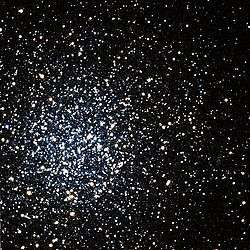NGC 2419
| NGC 2419 | |
|---|---|
|
| |
| Observation data (J2000 epoch) | |
| Class | VII[1] |
| Constellation | Lynx |
| Right ascension | 07h 38m 08.51s[2] |
| Declination | +38° 52′ 54.9″[2] |
| Distance |
275 kly (from the Sun) 300 kly (from the GC) (84.2 kpc (Sun) 91.5 kpc (GC)[3]) |
| Apparent magnitude (V) | +9.06[2] |
| Apparent dimensions (V) | 6′ |
| Physical characteristics | |
| Mass | 22,000 M☉ |
| Radius | 260 ly[4] |
| VHB | 20.45[3] |
| Metallicity | = –2.14[5] dex |
| Estimated age | 12.3 Gyr[5] |
| Other designations | GCl 112,[2] Caldwell 25 |
NGC 2419 (also known as Caldwell 25) is a globular cluster in the constellation Lynx. It was discovered by William Herschel on December 31, 1788.[6] NGC 2419 is at a distance of about 300,000 light years from the solar system and at the same distance from the galactic center.

NGC 2419 bears the nickname "the Intergalactic Wanderer," which was bestowed when it was erroneously thought not to be in orbit around the Milky Way. Its orbit brings it further away from the galactic center than the Magellanic Clouds, but it can (with qualifications) be considered as an element of the Milky Way. At this great distance it takes three billion years to make one trip around the galaxy.[7]
The cluster is dim in comparison to more famous globular clusters such as M13. Nonetheless, NGC 2419 is a 9th magnitude object and is readily viewed, in good sky conditions, with good quality telescopes as small as 102mm (four inches) in aperture. Intrinsically it is one of the brightest and most massive globular clusters of our galaxy, having an absolute magnitude of -9.42[3] and being 900,000 times more massive than our Sun.[8]
It was proposed too NGC 2419 could be, as Omega Centauri, the remnant of a dwarf spheroidal galaxy disrupted and accreted by the Milky Way.[9] However, later research seems to disprove that possibility[10]
Astronomer Leos Ondra has noted that NGC 2419 would be the "best and brightest" for any observers in the Andromeda Galaxy, looking for globular clusters in our galaxy since it lies outside the obscuring density of the main disk.[7] This is analogous to the way the cluster G1 can be seen orbiting outside of the Andromeda Galaxy from Earth.
References
- ↑ Shapley, Harlow; Sawyer, Helen B. (August 1927), "A Classification of Globular Clusters", Harvard College Observatory Bulletin (849): 11–14, Bibcode:1927BHarO.849...11S.
- 1 2 3 4 "SIMBAD Astronomical Database". Results for NGC 2419. Retrieved 2006-11-17.
- 1 2 3 Harris, W.E. (1996). "A Catalog of Parameters for Globular Clusters in the Milky Way". AJ. 112: 1487. Bibcode:1996AJ....112.1487H. doi:10.1086/118116.
- ↑ distance × sin( diameter_angle / 2 ) = 260 ly. radius
- 1 2 Forbes, Duncan A.; Bridges, Terry (May 2010), "Accreted versus in situ Milky Way globular clusters", Monthly Notices of the Royal Astronomical Society, 404 (3): 1203–1214, arXiv:1001.4289
 , Bibcode:2010MNRAS.404.1203F, doi:10.1111/j.1365-2966.2010.16373.x.
, Bibcode:2010MNRAS.404.1203F, doi:10.1111/j.1365-2966.2010.16373.x. - ↑ http://messier.seds.org/xtra/ngc/n2419.html NGC 4189 at SEDS
- 1 2 Ferris, Timothy. Seeing in the Dark. 2002. p. 244
- ↑ Baumgardt, H.; Côté, P.; Hilker, M.; Rejkuba, M.; et al. (2009). "The velocity dispersion and mass-to-light ratio of the remote halo globular cluster NGC2419". Monthly Notices of the Royal Astronomical Society. 396 (4): 2051–2060. arXiv:0904.3329
 . Bibcode:2009MNRAS.396.2051B. doi:10.1111/j.1365-2966.2009.14932.x.
. Bibcode:2009MNRAS.396.2051B. doi:10.1111/j.1365-2966.2009.14932.x. - ↑ van den Bergh, Sidney; Mackey, A. D. (2004). "Globular clusters and the formation of the outer Galactic halo". Monthly Notices of the Royal Astronomical Society. 354 (3): 713–719. arXiv:astro-ph/0407346
 . Bibcode:2004MNRAS.354..713V. doi:10.1111/j.1365-2966.2004.08228.x.
. Bibcode:2004MNRAS.354..713V. doi:10.1111/j.1365-2966.2004.08228.x. - ↑ RIPEPI V.; CLEMENTINI G.; DI CRISCIENZO M.; GRECO C.; et al. (2007). "On the remote galactic globular cluster NGC 2419.". The Astrophysical Journal. 667: L61–L64. arXiv:0705.0966
 . Bibcode:2007ApJ...667L..61R. doi:10.1086/522000.
. Bibcode:2007ApJ...667L..61R. doi:10.1086/522000.
External links
| Wikimedia Commons has media related to NGC 2419. |
- SEDS – NGC 2419
- perseus.gr – NGC 2419 in a LRGB CCD image based on 2 hrs total exposure
- APOD (2009-01-23) – NGC 2419
- NGC 2419 on WikiSky: DSS2, SDSS, GALEX, IRAS, Hydrogen α, X-Ray, Astrophoto, Sky Map, Articles and images
- NGC 2419 at the SIMBAD Astronomical Database.
- Ids - Bibliography - Image - B&W Image.
Coordinates: ![]() 07h 38m 08.51s, +38° 52′ 54.9″
07h 38m 08.51s, +38° 52′ 54.9″
